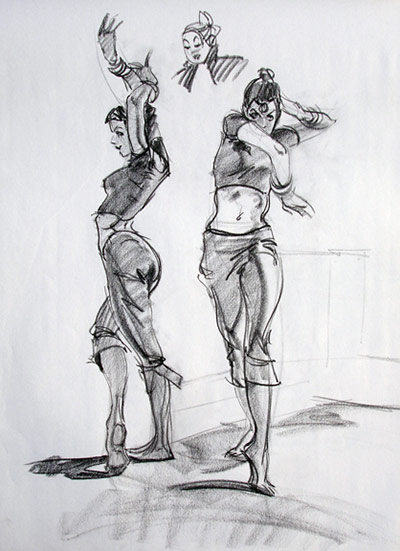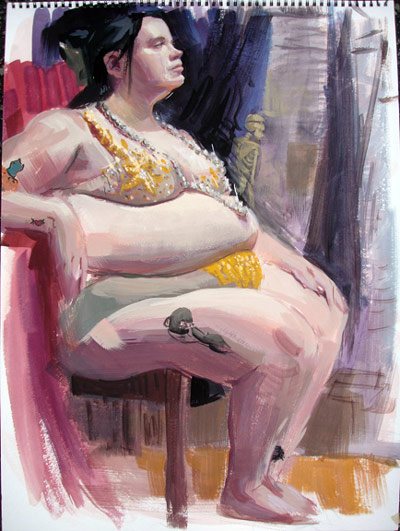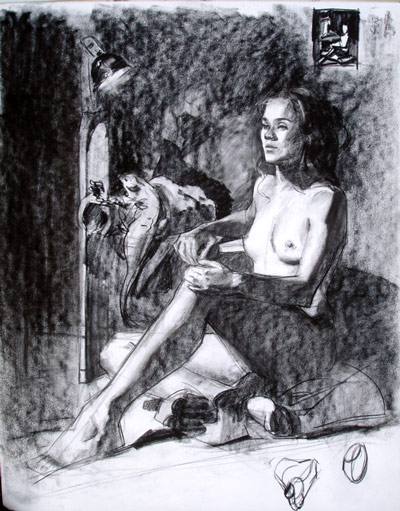April Connors


GW: Tell us about yourself: what is your current occupation and what was your journey into this?
AC: I am a freelance illustrator and instructor. I chose the freelance path because it affords me a great deal of freedom – something I highly value – and enables me to manage my own time. Being able to teach classes as a part time instructor means I can experience different students from different schools, and teach classes with slightly different focuses and learning outcomes, which serves to further improve not only my understanding of the craft of drawing, but also how to teach drawing more effectively to a broader range of learning styles and personality types.
GW: You’ve exhibited around the world, in the likes of Mexico, Hong Kong, as well as here in the United States. Which exhibitions were you proudest to be a part of, and how did you get your work included in those?
AC: Personally, the shows that meant the most to me are the shows in Hong Kong and Mexico. I think the Hong Kong show was probably most important to me since it was in a foreign country where the language and culture are so different from here that it was a surprise to see my work so warmly received. That show was also completely curated by my very good friend Pei Sea Low, a great artist herself. I always seek out the artist communities of places I go to and participate in different types of local events. Traveling and collaborating with other artists around the world is a great way for people to develop their craft and broaden their range of experiences so as to better inform their art..
GW: You work in a variety of traditional media. Do you have any favorite tools and techniques? Can you explain what they are and why you prefer them?
AC: I'm fond of quite a few different mediums, particularly charcoal sticks, brush and ink, and gouache. I love experimenting with new tools, techniques, and media, so going to the art store is a real treat! Lately, I've been having great fun with jumbo charcoal sticks for figure drawing, since the large blockiness keeps you focused on the bigger picture, rather than letting you be tempted by small details.
For painting, I'm really into gouache at the moment. I've always loved this medium, but I never favored it as much for observational studies as oil; however, the technique I use for it mirrors my Photoshop painting technique in a variety of ways, so I feel like I can kind of kill two birds with one stone. I also love the creamy consistency of gouache, or the “hand-feel” if you will; it's also quite versatile and can be used with a variety of surfaces, materials, and techniques to achieve a large array of styles and effects. Additionally, it captures brushstrokes very articulately – which can heighten the final effect of any picture!

GW: You’re primarily a traditional figurative illustrator, but what benefits can digital tools add to a traditional artist’s workflow?
AC: My go-to digital medium is Photoshop, but I also like experimenting with other software. I haven't explored all the software available, but there are alternatives to Photoshop that are pretty rocking. I love drawing and painting digitally for the freedoms it provides but also for simplicity: I don't have to make a mess or clean up (I hate cleaning up my messes). I also don't have to use up my materials and supplies – and the possibilities are essentially endless! Plus, the hand feel is different working digitally versus traditionally, so it's a nice break from traditional.
Photoshop also provides a fast and effective way of comping together a painting or finished work and being able to change it without having to use up materials on sketches, studies, and so on. Photoshop is both a great tool and an effective medium, and every artist should learn how to navigate a digital medium like it – if not Photoshop, then something else. However, I don’t believe that it is a replacement for traditional media, nor traditional drawing and painting practices or techniques.
GW: Your work has a beautiful fashion illustration feel to it. Can you explain some of the main objectives when drawing for fashion and designing costumes?
AC: While I've never considered myself a fashion illustrator, I have been mentored in that discipline by Miguel Angel Reyes, an exceptional and highly regarded Fashion Illustrator and Fine Artist. Having taught fundamentals of drawing for fashion, I would consider some of the main objectives to be: the careful observation of both the human form and the effects of draping, shaping, and styling fabrics and materials on both the male and female figure, as well as understanding the concepts of idealization and beauty.
Other key objectives include: understanding the manipulation of proportions while maintaining believable, naturalistic anatomy; understanding the importance of the silhouette; experimenting and understanding shapes; editing and simplification. In terms of drawing technique, it's all about that contour line!

GW: You’re an instructor at Gnomon in Hollywood, as well as the Gnomon Workshop. What are some of the most frequently asked questions you receive from your students when it comes to gesture and figure drawing?
AC: Generally speaking, the most common questions I get are related to either construction/structure issues, or gesture issues. In figure drawing, the most common problem that arises is the lack of gesture; in gesture drawing, it's the inverse problem: a lack of construction/structure. I will usually prescribe specific homework exercises and/or techniques to address drawing issues on an individual student basis since everyone is different.
GW: What are the challenges of drawing costumed models compared to nude figures, and do you have any advice for tackling these?
AC: When drawing costumed models one must take into account both the figure as well as the stuff on the figure and how the shapes affect the silhouette, movement, gesture, and characterization/personality/attitude. Additionally, handling the different materials and textures provide a further challenge to the artist. Costuming can also affect the mood and tone of a drawing or painting, and therefore challenge the artist to think more in terms of story and character, rather than just replicating what is being observed.
I recommend doing as much nude figure drawing and costumed figure drawing as possible. Do both short-pose and long-pose studies of both, drawn as well as painted; still-life and drapery studies are also a definite must. The idea is to understand how costuming will affect and be affected by the human body, as well as how to communicate different textures and materials. Any exercise or study that aids in those outcomes is recommended. Additionally – if one has time – learning how to make a garment and how to style will also enrich your drawing and painting.

GW: And how about the challenges of gesture drawing compared to life drawing – what should artists be focusing on when capturing gesture, and how should they think differently?
AC: I see gesture drawing as a fundamental part of figure drawing and design, I don’t consider them to be separate or individual; however, when teaching and/or learning drawing, it's a much better idea to take small bites and tackle issues one at a time rather than be overwhelmed with all there is to developing draughtsmanship. That being said, when teaching figure drawing – especially to people who have limited or no experience drawing at all – I will focus first on fundamentals such as mechanical techniques, like holding and sharpening different drawing tools; differences between drawing surfaces; utilizing the drawing horse with good form; and so on.
The majority of the 10 weeks of Gesture Drawing class is spent learning how to see and translate a complex, organic three-dimensional form configuration onto a two-dimensional picture plane, and how to utilize concepts from other Gnomon classes, Perspective and Vis Com 1 – which the students are taking concurrently with Figure Drawing 1 – to do so. We also do what I would call “observation” exercises, which focus predominantly on contour line. I was taught to use these exercises at Otis Fashion, and since I saw excellent results, I've since adopted them for my Gnomon classes.
Gesture drawing depends on students already understanding structure, perspective, fundamentals such as primitive shapes/forms, basic anatomy, and design fundamentals such as shape, line, form, positive/negative space, in order to focus solely on key concepts which are more abstract in nature. We focus more on movement, energy, exaggeration, rhythm, harmony, storytelling, characterization, acting, simplification, efficiency in visual communication, and achieving and maintaining visual clarity. We also work on developing drawings that are full of life, and how to tie ideas from traditional 2D animation to our non-animated work.
GW: When it comes to digital artists looking to hone their traditional skills – where would you recommend they begin to sharpen up on the fundamentals?
AC: I would say do a lot of drawing. It doesn't matter what you use, as long as you have some kind of surface and some kind of drawing tool. You can't go wrong with pencil and paper. Draw everything! Take a sketchbook everywhere you go. Practice perspective, concepts from visual communication – such as primitive shapes and forms; textures and rendering – and do as much life drawing as possible. Even if not taking any drawing classes, just draw as much from observation as is possible. Drawing is just as much learning how to see as it is putting marks on a surface!
GW: Artists often fear the blank canvas. What are your tips for getting the brain flowing with ideas, and breaking through the barrier?
AC: I've heard of this “fear” before; I see it as a kind of “performance anxiety”. I've talked to a couple of different artists who find drawing or painting on a surface that has already been marked to ease this “fear”. I think confidence is the best remedy for getting over the fear of marring a blank surface; that confidence comes with mileage and experience, which I'm sure is something every teacher has told their students at some point.
There really is no substitute for mileage and experience, and the more you draw the more confident you become – even if you don't realize it. When it comes to generating ideas and brainstorming, I find that the more you can enrich your life with, the easier it is to think of things. For example, you shouldn't only focus on drawing, but rather expand your mind with different disciplines, whether they come from the humanities or other academic fields. Just because you're a visual artist doesn't mean you can't have hobbies or interests outside of the visual arts; the more you experience the easier it is to brainstorm and create work that has emotional resonance.
GW: It’s also common to hear the phrase, “I wish I could draw”. What is your advice for those non-believers? Do you really have to be born with an aptitude for drawing, or can anyone do it?

AC: I really believe that every human on Earth is born with the innate ability to draw or otherwise non-verbally communicate. Whether we choose to hone that skill is entirely up to circumstance and/or choice. I've had students with limited or no experience with drawing, and with diligence, patience, discipline, and practice, have been able to nurture the skill enough to begin to communicate in a way that not only pleases them, but also contains efficiency in visual communication.
Another issue that arises with “non-believers” is simply that they do not understand how they learn, personally. The first step in education is understanding how YOU learn as an individual, what methods and techniques work best for YOU. Everyone is different, and everyone learns differently. Understanding your own strengths and weaknesses is step one in learning how to do anything. The rest is diligence and discipline.
GW: Tell us about your latest Gnomon Workshop training, Developing Storytelling Skills from Life. Who is this for, and what will viewers learn from this training?
AC: This Gnomon Workshop tutorial is really meant for anyone who wants to “spice up” their life drawing, and start to think of life drawing/observational studies as more than just replicating what's in front of them. My hope with this tutorial is to inspire a love for creative problem-solving and experimentation with traditional drawing/painting techniques and media, in order to boost confidence with the creative process, which can then be translated to the digital medium, or any other medium for that matter.
GW: As well as teaching Figure Drawing and Gesture Drawing for Animation at Gnomon, you also taught at the High School Summer Camp this year?
AC: Yes, we went over a variety of drawing fundamentals, such as introductions to the concepts of perspective, visual communication, figure drawing, and other observational-based studies. Figure drawing and gesture drawing are both essential for learning how to communicate visually, using a visual language. Learning how to see and interpret the world and life around you make up the foundation of the visual arts, and to delve into an artistic career without understand those two things is like trying to run without ever having learned to stand up, or trying to frost a cake without having baked it yet.
GW:Finally, do you have any top pieces of advice for artists starting out in traditional figurative illustration?
AC: Yes, draw anything and everything. Also, make room in your life for experimentation and gaining experience. Enrich your life as much as possible!
| Check out April Connor's tutorial |





